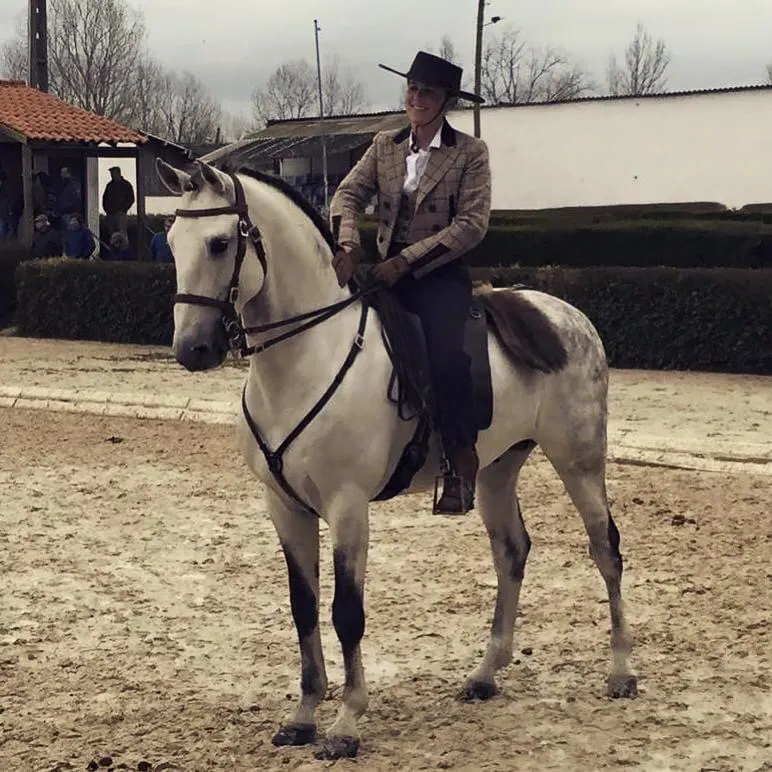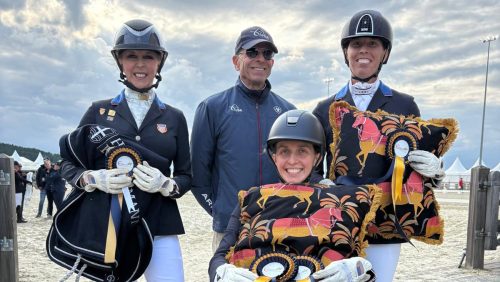Name: Lauren Taylor Harding
Age: 38
Day Job: Co-executive producer of “The Masked Singer” on Fox in Los Angeles
Lauren Taylor Harding laughs when you ask her about her daily schedule. By day, she’s a co-executive producer on “The Masked Singer,” one of the highest-rated shows on primetime television. But in the early hours of the morning, she’s just another rider at the barn—one who has trained her 15-year-old Lusitano, Arisco, through Prix St. Georges.
“Basically, it’s nuts,” Harding explained. “I managed to choose the world’s most time-consuming job and the world’s most time-consuming hobby. Most days, I literally run home to get changed and to work by 8. My job varies day to day, depending on whether we’re in pre-production and I’m managing the team, or I’m on set and taping all day with all the prep before and after, or in post-production, which means I’m working with editors to cut the show. It’s 10 to 12 hours, minimum. Then it’s home, rinse, repeat.”
Harding has spent the past 15 years working her way up in the entertainment industry. She’s been a producer for shows like “The X-Factor” and “America’s Got Talent,” and filled roles around the sets of countless others. Usually, the last phase of one project overlaps with the first of another as she races from season to season.
Until five years ago, Harding couldn’t imagine making time for horses in her schedule. In fact, she couldn’t make time for much of anything.
“It felt to me like I was working so much, it was all I had in life,” Harding said. “I missed weddings and birthdays and Thanksgiving at home several years in a row, and I felt like I had nothing to show for it. It was like two years were just over in a second, and I thought, ‘Is this how it’s going to be forever?’ ”
Pony Club For A Brighter Future
Harding learned to ride from her mom, Carolyn Carroll, a professional dressage trainer in Redding, California.
“My brother and sister and I were all really involved—a lot of riding after school and chores, of course,” Harding said. “Mom definitely would crack the whip on us, which made for a really well-rounded education in horses. To this day I can build a really good fence.”
Despite Carroll’s focus in dressage, Pony Club dominated Harding’s early years in the saddle. Carroll was the district commissioner for the local club, and Harding started at 4 or 5, learning to do everything independently.
“Honestly, I tell people all the time at work, the reason I’m able to do my job effectively is because I grew up in Pony Club,” she said. “Getting my hands dirty, juggling a lot of things at once, being super self-sufficient—I grew up on that so much so that now, it’s just second nature.”
ADVERTISEMENT
Harding lived on hand-me-downs, from ponies and off-the-track Thoroughbreds to ancient Stubbens and show coats, and she gravitated towards eventing.
She spent a gap year during college as a working student for Mara DePuy in Round Hill, Virginia, before committing to the entertainment industry.
“Starting out, I was making $550 a week for 80 hours of work, living on ramen noodles,” Harding said. “I didn’t have time or resources to ride. I’d sneak away on an occasional Sunday to groom for my mom or sister, Allison Mathy, who’s a professional dressage rider. But in entertainment you work most weekends, so even that was really hard. Horses, though, once you get the bug, you can never really forget about riding.”

Lauren Taylor Harding leaned the art of working equitation in Portugal. Photo Courtesy Of Lauren Taylor Harding
Eat, Pray, Lusitanos
When years of back-to-back productions left Harding burned out in 2015, her mind wandered to horses.
“I saw a notice on Facebook for someone in Portugal looking for an assistant to come work in exchange for room and board,” Harding said. “I was finishing up one show, and the offer on the next one wasn’t as great as I wanted. So, I answered the ad. I had to make a video, which meant I had to call my sister and friends with horses in the L.A. area. Over a couple afternoons, I cobbled together a phone video and sent it. I got the job. Then, it was like, ‘Oh, I guess I’ve got to move to Portugal!’ ”
Harding spent eight months working in Portugal, first for Paulo Sérgio Perdigão and then at the Centro Equestre Vale do Lima. She was familiar with the Lusitano breed because of her mom, who had fallen in love with them as a student to Egon von Neindorff in her youth. But Harding did not know anything about the region’s most popular event: working equitation.
“Horses still work in Portugal on farms and ranches, and the sport is built on that concept,” Harding explained. “The first phase is a dressage test. The second is called ‘Ease of Handling,’ and it’s essentially an obstacle course mixed with dressage elements. The third is the same thing, only as fast as you can do it. And for the fourth phase, you work cows.
“I had never done anything like that before, and the learning curve was insane,” Harding continued. “I learned from Miguel da Fonseca, who was a champion in Portugal. It was basically him screaming at me, and me only understanding every fifth word. At my first competition, no one handed me the document with the patterns, so I literally just watched the people in front of me and did what they did. Horses are so much a part of the culture there, though. No one seemed to mind the crazy American trying to keep up. They loaned me horses and welcomed me right in.”
A Small But Mighty Souvenir
“I’d almost emptied my savings, and my visa had nearly expired, but I started thinking toward the end of my trip that maybe I should buy a horse,” Harding said. “Stuff is really cheap there, and you can get a high-quality horse for a lot better price than in the States. I started looking and just had heartbreak after heartbreak. I must have looked at 20 horses, but the vettings kept coming back with piroplasmosis diagnoses, which is a blood virus that 70 percent of horses there have that’s not allowed in horses imported to the U.S.”
ADVERTISEMENT
Harding had recently started riding da Fonseca’s 10-year-old Lusitano, Arisco (Que Juizo—Ternura, Marujo)—a spunky, 15-hand stallion with “a bit of a Napoleon complex.” Fonseca agreed to sell him to her if his test came back negative, which it did.
“I had to be really honest with this man and say I have almost nothing to give you right now,” Harding said. “I traded my car as a down payment along with other little items I had, then I paid the rest over the next year. I flew home first, and, after he was gelded, he met me here in L.A.”

Lauren Taylor Harding works hard at her day job to be able to enjoy her horse Arisco. Photo Courtesy Of Lauren Taylor Harding
Old Routine, New Purpose
Harding had a rough first year after her trip. A car accident put her out of work for several months, and in general, she felt down about the prospect of returning to her old routine.
On the set of her next project, however, she found her perspective changed.
“For the first time, it felt like everything I earned from work had a purpose beyond food and a roof over my head,” Harding said. “I knew that if I worked really hard, the payoff was I got to go ride. I was able to move into an apartment close to the stable, which made it doable. I didn’t have a trainer at the time, but I would call my mom every day after my ride and say, ‘OK, this is happening. What do I do now?’ ”
Harding continued to practice working equitation, but she could tell Arisco had a real talent for dressage. She started taking lessons with Kristina Harrison, often in the hours before dawn, and showing on the weekends.
In 2018, she and Arisco debuted at Prix St. Georges, her first FEI appearance. They even qualified for the regional championships and finished in the top 10. A ligament injury meant Arisco sat out 2019, but he’s come back to form, and next year, Harding is hoping for Intermediaire I or maybe even Grand Prix.
“I’ve had shows where I have to drive directly from the showgrounds to work, change in the bathroom, and put a hat on to hide my helmet hair for the day,” Harding said. “Sometimes I’m rushing so much to get to the next thing that I forget to even stop and think about what’s happening. But it will hit me eventually, and I’ll just stop what I’m doing and be really happy and proud. I may never get another horse like I have now, and I know it was a miracle I found him, a miracle I had any money at all to buy him and bring him here.
“The professionals out there work their butts off to get where they are, but hats off to the amateurs too, who get up every day with a goal in mind, and try to reach that dream while holding down a job to make it all possible,” Harding continued. “At 38, I’m single, I live in a one-bedroom apartment, but this is the life I made for myself. Every day, the alarm goes off, and I jump right out of bed because I get to go get on my horse and breathe the fresh air before I go to work. What could be better than that?”
Do you know of a cool amateur rider who deserves to be featured? Email Lindsay at lberreth@coth.com.
















